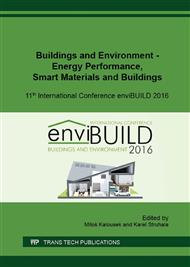p.353
p.361
p.369
p.376
p.384
p.392
p.401
p.409
p.417
Impact of Inlet Boundary Conditions on the Fluid Distribution of Supply Duct
Abstract:
Ventilation is important to maintain the indoor air quality and other comfort parameters in the occupied zone. The design of ventilation systems is based on one dimensional approach. When the air distribution is modelled in the ventilated space usually CFD simulation is performed and simplified boundary conditions are defined at the locations where the supply air enters the room. However, in some cases it is difficult to predict the duct flow by 1D methods. The flow in the duct system determines the outflow at the air terminal devices. The interaction between the multiple system elements is important, since many different combinations are possible, for instance multiple bends can create a special flow field which also influences the distribution performance of the duct. It is very important to determine this impact, because the room airflow depends on it. In this study the impact of the inlet boundary conditions on the fluid distribution performance of a special supply duct –which is designed to provide uniform distribution– is investigated with CFD. Three different inlet boundary conditions are defined: constant inlet velocity and turbulence parameters estimated from intensity and hydraulic diameter, diffuser after fully developed turbulent pipe flow, diffuser with one bend and a Venturi-tube upstream. In each case, the simulations are performed with the realizable k-epsilon model. The reliability of the results is estimated with the grid convergence index.
Info:
Periodical:
Pages:
384-391
Citation:
Online since:
December 2016
Authors:
Keywords:
Price:
Сopyright:
© 2017 Trans Tech Publications Ltd. All Rights Reserved
Share:
Citation:


